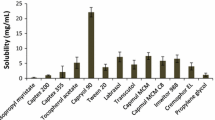Abstract
Microcapsules of volatile oil containing Herba Schizonepetae (VOHS) were prepared by emulsion solvent diffusion method to improve the drug loading and reduce the amount of pharmaceutical excipients. Orthogonal assay was applied to optimize the preparation condition of microcapsulation, and the results illustrated that the ratio of ethyl cellulose (EC) to VOHS influenced the property of VOHS microcapsule significantly. GC-MS analysis indicated that some volatile components with low concentration in VOHS were lost after microencapsulation. The microcapsules prepared with optimum condition had good fluidity, and the holes on the surface of the microcapsules contributed to the release of VOHS. The particles of the microcapsule conformed to a normal distribution with the diameter of 45–220 μm. In the simulated intestinal fluid containing 0.2% sodium dodecyl sulfate, pulegone in VOHS microcapsule showed a certain degree of slow release. Compared with β-cyclodextrin method, the microencapsulation used in the present work could reduce the amount of excipients and increase the drug loading. It was beneficial to reduce the dose of Chinese medicines containing volatile oils.
Similar content being viewed by others
References
Bakkali F, Averbeck S, Averbeck D et al. Biological effects of essential oils: A review [J]. Food and Chemical Toxicology, 2008, 46(2): 446–475.
Burdock G A, Carabin I G. Safety assessment of coriander (Coriandrum sativum L.) essential oil as a food ingredient [J]. Food and Chemical Toxicology, 2009, 47(1): 22–34.
Jiangsu New Medical College. Dictionary Chinese Traditional Drugs [M]. Shanghai Scientific and Technical Publishers, Shanghai, 1997 (in Chinese).
National Pharmacopoeia Committee. Pharmacopoeia of People’s Republic of China[S]. Chinese Medical Science and Technology Press, Beijing, 2000(in Chinese).
Hao L P, Yu S F, Yu X L et al. Study on influenza virus inhibition effect of Jin, Fang, Cai and Ju [J]. People’s Military Surgeon, 1992, 47(11): 49–50 (in Chinese).
Bian R L, Yang Q H, Ren X Y et al. Resemhon pharmacological effect of the volatile oil of Schiszonepeta Tenmfolia Briq[J]. Journal of Zhejiang Medical University, 1981, 10(5): 219 (in Chinese).
Bian R L, Chen J. Preparation technology for essential oil-β-cyclodextrin inclusion complex [J]. Lishizhen Medicine and Materia Medica Research, 2005, 16(3): 191–192 (in Chinese).
Vobalaboina V, Kopparam M. Preparation, characterization and in vitro release kinetics of clozapine solid lipid nanoparticles [J]. Journal of Controlled Release, 2004, 95(3): 627–638.
Hildegard S. Process for the Production of Microgranulates: US 3737337 [P]. 1973.
Liu L, Xie Q Q, Yu D S. The study of β-cyclodextrin inclusion of essential oils from Herba Schizonepeta by orthogonal experimental design [J]. China Journal of Chinese Materia Medica, 2000, 25(3): 348–349 (in Chinese).
Zhang L G, Wang F X, Zhang C. The process and evaluation of β-cyclodextrin inclusion of essential oils from Rhizoma Chuanxiong [J]. Chinese Traditional Patent Medicine, 2011, 33(8): 1432–1435 (in Chinese).
Yu Y H, Li X C, Wu T et al. Study on liposome preparation technique of Bupleurum Chinese volatile oil for injection [J]. China Journal of Chinese Materia Medica, 2004, 29(6): 522–525 (in Chinese).
Kristl A, Bogataj M, Mrhar A et al. Preparation and evaluation of ethylcellulose microcapsules with bacampicillin [J]. Drug Development and Industrial Pharmacy, 1991, 17(8): 1109–1130.
Perumal D. Microencapsulation of ibuprofen and Eudragit® RS 100 by the emulsion solvent diffusion technique [J]. International Journal of Pharmaceutics, 2001, 218(1): 1–11.
Yan S, Zou M J, Xu C H et al. Preparation and characterization of the sustained release microspheres of lutein by the emulsion solvent diffusion method [J]. Chinese Journal of Pharmaceutics, 2009, 7(3): 391–398 (in Chinese).
Dong Z J, Toure A, Jia C S et al. Effect of processing parameters on the formation of spherical multinuclear microcapsules encapsulating peppermint oil by coacervation [J]. Journal of Microencapsulation, 2007, 24(7): 634–646.
Alan S, Ian M. Evaluation of poly (lactic acid) as a biodegradable drug delivery system for parenteral administration [J]. International Journal of Pharmaceutics, 1986, 30(2): 215–220.
Anderson J M, Shive M S. Biodegradation and biocompatibility of PLA and PLGA microspheres [J]. Advanced Drug Delivery Reviews, 1997, 28(1): 5–24.
Koida Y, Hirata G, Samejima M. Studies on microcapsules(II): Influence of molecular weight of ethyl cellulose in the microencapsulation of ascorbic acid [J]. Chemical Pharmaceutical Bulletin, 1983, 31(12): 4476–4482.
Nixon J R, Meleka M R. The preparation and characterization of ethyl cellulose-walled theophylline microcapsules [J]. Journal of Microencapsulation, 1984, 1(1): 53–64.
Wang J M, Zheng W, Song Q W et al. Preparation and characterization of natural fragrant microcapsules [J]. Journal of Fiber Bioengineering and Informatics, 2009, 1(4): 293–299.
Zhang L G, Zhang C, Ni L J et al. Rectification extraction of Chinese herbs’ volatile oils and comparison with conventional steam distillation [J]. Separation and Purification Technology, 2011, 77(5): 261–268 (in Chinese).
Ni L J, Luo J Q, Xie J et al. Extraction Device and Extraction Method of Volatile Components: CN, 200810032234. 9[P]. 2008-10-01 (in Chinese).
Zhang L G, Wang F X, Ni L J et al. Extraction technology optimization and quality analysis of volatile oil in Rhizoma Curcumae [J]. Journal of Chinese Medicinal Materials, 2012, 35(3): 471–475 (in Chinese).
Wang F X. Preparation and Evaluation of Microcapsules of Curcuma and Nepeta Oil [D]. School of Chemistry and Molecular Engineering, East China University of Science and Technology, Shanghai, 2012 (in Chinese).
Li X R, Liang Y Z, Zhou T et al. Comparative analysis of volatile constituents between recipe Jingfangsan and its single herbs by GC-MS combined with alternative moving window factor analysis method [J]. Journal of Separation Science, 2009, 32(2): 258–266.
Moodley J, Coulter I. Microcapsules Comprising a Methyl Xanthine and a Corticosteroid: EP 1811979B1 [P]. 2006-01-04.
Author information
Authors and Affiliations
Corresponding author
Additional information
Supported by the Plan Issue of Shanghai Science & Technology Committee (No. 13401901100).
Zhang Liguo, born in 1963, male, Dr, associate Prof.
Rights and permissions
About this article
Cite this article
Zhang, L., Ouyang, X., Ni, L. et al. Preparation and evaluation of microcapsule containing volatile oil of Herba Schizonepetae by emulsion solvent diffusion method. Trans. Tianjin Univ. 20, 103–111 (2014). https://doi.org/10.1007/s12209-014-2182-1
Accepted:
Published:
Issue Date:
DOI: https://doi.org/10.1007/s12209-014-2182-1




